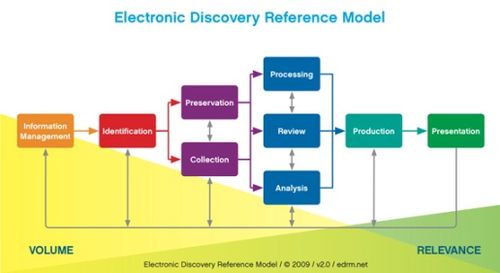eDiscovery Daily Blog
Reporting from the EDRM Mid-Year Meeting

Launched in May 2005, the Electronic Discovery Reference Model (EDRM) Project was created to address the lack of standards and guidelines in the electronic discovery market. Now, in its sixth year of operation, EDRM has become the gold standard for…well…standards in eDiscovery. Most references to the eDiscovery industry these days refer to the EDRM model as a representation of the eDiscovery life cycle.
At the first meeting in May 2005, there were 35 attendees, according to Tom Gelbmann of Gelbmann & Associates, co-founder of EDRM along with George Socha of Socha Consulting LLC. Check out the preliminary first draft of the EDRM diagram – it has evolved a bit! Most participants were eDiscovery providers and, according to Gelbmann, they asked “Do you really expect us all to work together?” The answer was “yes”, and the question hasn’t been asked again. Today, there are over 300 members from 81 participating organizations including eDiscovery providers, law firms and corporations (as well as some individual participants).
This week, the EDRM Mid-Year meeting is taking place in St. Paul, MN. Twice a year, in May and October, eDiscovery professionals who are EDRM members meet to continue the process of working together on various standards projects. EDRM has eight currently active projects, as follows:
- Data Set: provides industry-standard, reference data sets of electronically stored information (ESI) and software files that can be used to test various aspects of eDiscovery software and services,
- Evergreen: ensures that EDRM remains current, practical and relevant and educates about how to make effective use of the Model,
- Information Management Reference Model (IMRM): provides a common, practical, flexible framework to help organizations develop and implement effective and actionable information management programs,
- Jobs: develops a framework for evaluating pre-discovery and discovery personnel needs or issues,
- Metrics: provides an effective means of measuring the time, money and volumes associated with eDiscovery activities,
- Model Code of Conduct: evaluates and defines acceptable boundaries of ethical business practices within the eDiscovery service industry,
- Search: provides a framework for defining and managing various aspects of Search as applied to eDiscovery workflow,
- XML: provides a standard format for e-discovery data exchange between parties and systems, reducing the time and risk involved with data exchange.
This is my fourth year participating in the EDRM Metrics project and it has been exciting to see several accomplishments made by the group, including creation of a code schema for measuring activities across the EDRM phases, glossary definitions of those codes and tools to track early data assessment, collection and review activities. Today, we made significant progress in developing survey questions designed to gather and provide typical metrics experienced by eDiscovery legal teams in today’s environment.
So, what do you think? Has EDRM impacted how you manage eDiscovery? If so, how? Please share any comments you might have or if you’d like to know more about a particular topic.
